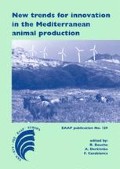Abstract
The Greek deer industry made its appearance recently, with the establishment of a few small private deer farms with minimal (basic) infrastructures and imported breeding stock. The Department of Forestry owns three State farms where indigenous red deer are raised. The deer population used in this study was composed of 70 hinds and 17 stags, raised in Northern Greece, at the public red deer farm of Chrisopigi, near the city of Serres. Due to the lack of introducing new bloodlines in the herd for more than 20 years and indications of genetic drift, based on the low birth rate of the herd in addition to abnormal phenotypic characteristics (antler deformation), the inbreeding rate (ΔF) and the effective population size (Ne) over 1 generation of the population, was estimated. The average generation interval (L) was estimated to be four years, while 48 and 16 new hinds and stags respectively, enter the herd each generation. The results indicated that the expected rate of inbreeding in each generation was approximately 0.91% while the calculated effective population size was 45.6 animals. According to the literature, the effective population size is slightly below of the critical threshold required number of animals (50), indicating that there is a build up of mutational load. The above results lead to the conclusion that immediate measures should be taken in order to reduce inbreeding rate and increase the effective population size.
Access this chapter
Tax calculation will be finalised at checkout
Purchases are for personal use only
References
Bennewitz, J., H. Eding, J. Ruane and H. Simianer, 2007. Selection of breeds for conservation. In: Utilization and conservation of farm animal genetic resources, K. Oldenbroek (editor), Wageningen Academic Publishers, Wageningen, The Netherlands, 131-146.
Lynch, M., J. Conery and R. Burger, 1995. Mutation accumulation and the extinction of small populations. American Naturalist 146: 489-518.
Meuwissen, T., 2007. Operation of conservation schemes. In: Utilization and conservation of farm animal genetic resources, K. Oldenbroek (editor), Wageningen Academic Publishers, Wageningen, The Netherlands, 167-193.
Simianer, H., 2005. Decision making in livestock conservation. Ecological Economics, 54: 559-572.
Simm, G., 2000. Genetic Improvement of Cattle and Sheep, Farming Press,Tonbridge, United Kingdom, 433 pp.
Stansfield, W.D. (ed.), 1983. Schaum’s outline of theory and problems of Genetics. McGraw-Hill, Inc., New York, USA, 266-287.
Woolliams J., 2007. Genetic contributions and inbreeding, In: Utilization and conservation of farm animal genetic resources, K. Oldenbroek (editor), Wageningen Academic Publishers, Wageningen, The Netherlands, 147-165.
Woolliams, J. and M. Toro, 2007. What is genetic diversity? In: Utilization and conservation of farm animal genetic resources, K. Oldenbroek (editor), Wageningen Academic Publishers, Wageningen, The Netherlands, 55-74.
Author information
Authors and Affiliations
Editor information
Rights and permissions
Copyright information
© 2012 Wageningen Academic Publishers
About this chapter
Cite this chapter
Vatzias, G., Asmini, E., Papavasiliou, D., Maglaras, G., Nagy, S., Zamborszky, Z. (2012). Red deer (Cervus elaphus) farming in Greece: predicting the rate of inbreeding and estimating the effective population size . In: Bouche, R., Derkimba, A., Casabianca, F. (eds) New trends for innovation in the Mediterranean animal production. EAAP – European Federation of Animal Science, vol 129. Wageningen Academic Publishers, Wageningen. https://doi.org/10.3920/978-90-8686-726-4_7
Download citation
DOI: https://doi.org/10.3920/978-90-8686-726-4_7
Publisher Name: Wageningen Academic Publishers, Wageningen
Online ISBN: 978-90-8686-726-4
eBook Packages: Biomedical and Life SciencesBiomedical and Life Sciences (R0)


